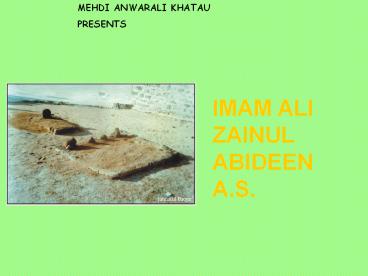MEHDI ANWARALI KHATAU PowerPoint PPT Presentation
1 / 32
Title: MEHDI ANWARALI KHATAU
1
MEHDI ANWARALI KHATAU PRESENTS
IMAM ALI ZAINUL ABIDEEN A.S.
2
His name is Ali And his title is Zainul Abideen
(The Jewel of Woshippers)
3
Kuniyat Abu Muhammad Father Imam Husain
(A) Mother Bibi Shahr Banu (A)
4
He was born on 5 Shaban 38 A.H. in Madina.
5
He led the Imamat from 61 A.H. to 95 A.H.
6
He was shahid on 25 Muharram 95 A.H. He is buried
in Madina , Saudi Arabia.
7
Imam (A) was the eldest son of Imam Husain (A).
His mother was the Persian princess Bibi Shahr
Banu (A), daughter of King Yazdjard II, the last
pre-Islamic ruler of Iran.
8
He spent the first two years of his life under
the care of his grandfather Imam Ali (A), and the
next ten or twelve years under the guardianship
of his uncle Imam Hasan (A).
9
In 61 A.H. he was present in Karbala, where his
father, relatives and the companions of his
father were mercilessly killed by the forces of
Yazid. At the time, he was too ill to fight and
was thus preserved by Allah to continue the line
of Imamat.
10
Imam (A) lived 34 years after his father and all
his life was passed in prayers and Du'as to Allah
and in the remembrance of the tragedy of Karbala.
11
His habit of frequent prostration in Sajdah
caused him to be popularly known as Sajjad. He
was also called 'Abid.
12
In his time, no one could equal the piety and
awareness of Allah that he possessed.
13
He was so mindful of Allah that whenever he sat
for Wudhu, the colour of his face would change
and when he stood for Namaaz his body would be
seen trembling.
14
When he was asked why he became like this, he
replied, "Do you not know before Whom I stand in
prayers, and with Whom I talk?"
15
Imam (A) had a habit of going out at night with
bags of money, food and even firewood.
16
When he reached the houses of the poor and needy,
he would distribute what he had without revealing
his identity. It was only after his death that
the people found out that their helper was
actually Imam (A) himself.
17
Imam (A) was part of the caravan of captives that
was led from Karbala to Kufa and then to Sham
after the martyrdom of Imam Husain (A) and his
companions.
18
The cruel army of Yazid chained the hands and
legs of Imam (A) and made him wear an iron
neckband with spikes facing inwards.
19
The chains used to heat up in the hot desert and
burn his flesh to the bone. These
wounds continued to give him discomfort for the
rest of his life.
20
In Sham, Imam (A) and the ladies and children of
the party of Imam Husain (A) were imprisoned in
very harsh conditions.
21
Yazid once called Imam (A) and asked him to
speak. Imam (A) gave such a powerful lecture that
the feelings of the people began to be swayed
towards him.
22
Yazid was alarmed at this and ordered that Adhaan
be recited so that Imam's (A) words would be cut
off. At this, Imam (A) commented that he was the
grandson of the same Muhammad (S) whose name they
were reciting in Adhaan.
23
Due to the pressure of public opinion, Yazid
decided to free his prisoners and let them return
to Madina.
24
But after his return, Imam (A) was again chained
and sent to Sham on the order of the Bani Umayyah
Caliph Abdul Malik. Later he was allowed to
return to Madina.
25
Once when the Bani Umayyah Caliph, Waleed bin
Abdul Malik, came for Haj, he could not get near
and kiss the Black Stone (Hajare Aswad) because
of the crowd of people.
26
While he was sitting waiting for the rush to die
down, he saw Imam (A) enter the Haraam and go
straight towards the Black Stone. The crowds
parted for him and he managed to kiss the blessed
stone quite easily.
27
Waleed was annoyed by this and asked who this man
was, although he had recognised Imam (A).
28
A Shia poet, Farazdak, who was standing nearby,
heard him and was irritated by the petty remark
of Waleed. In reply to Waleed's question he
composed a powerful and moving poem in praise of
Imam (A).
29
This poem exists today and is considered to be
one of the masterpieces of Arabic literature.
30
Imam (A) was prevented by the government to
preach openly so he used Du'as to guide the
people. His Du'as contained a wealth of teaching
and wisdom and many of them exist today.
31
His most famous work is the book of 57 Du'as
known as Sahifa-e-Kaamilah or Sahifae-Sajjadia.
32
Imam (A) was poisoned by Waleed bin Abdul Malik
in 95 A.H. and is buried in Jannatul Baqee in
Madina next to Imam Hasan (A).

